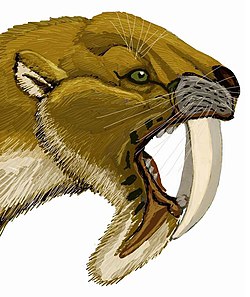Sparassodont
The Sparassodonta were an order of carnivorous metatherian mammals. They are all now extinct.[1]
| Sparassodonta Temporal range: Palaeocene–Pleistocene
| |
|---|---|

| |
| Thylacosmilus | |
| Scientific classification | |
| Kingdom: | |
| Phylum: | |
| Class: | |
| Infraclass: | |
| Order: | †Sparassodonta Ameghino, 1894
|

The sparassodonts were native to South America. They were once thought to be true marsupials, but are now classified as a sister taxon to them.[2][3]
A number of these mammalian predators closely resemble placental predators that evolved separately in Eurasia. They were first described by Florentino Ameghino, from fossils found in the Santa Cruz beds of Patagonia.
Features
Members of the order Sparassodonta showed many similarities with placental carnivora, but they were not closely related. They are a very good example of convergent evolution.
For example, sparassodont molars were similar to the meat slicing teeth of modern cats. The canines were also lengthened, and in some cases, such as Thylacosmilus, resemble those of saber-toothed cats like Smilodon. Their body size varied, ranging from 80 cm (2 ft 8 in) long to the size of today's modern big cats.
Another family of large predators wrere the borhyaenids, which were more like wolves or dogs.
Families
†Hathliacynidae
†Borhyaenidae
†Proborhyaenidae
†Thylacosmilidae
References
- ↑ *Goin, Francisco J (2003). "Early marsupial radiations in South America". In Menna Jones; Mike Archer; Chris Dickman (eds.). Predators with pouches: the biology of carnivorous marsupials. CSIRO. pp. 30–42. ISBN 9780643099487.
- ↑ Simpson, George Gaylord 1941. The affinities of the Borhyaenidae. American Museum Novitates 1118: 1–6.
- ↑ Naish, Darren (2008). "Invasion of the marsupial weasels, dogs, cats and bears... or is it?". Tetrapod zoology. Retrieved 2008-12-07.